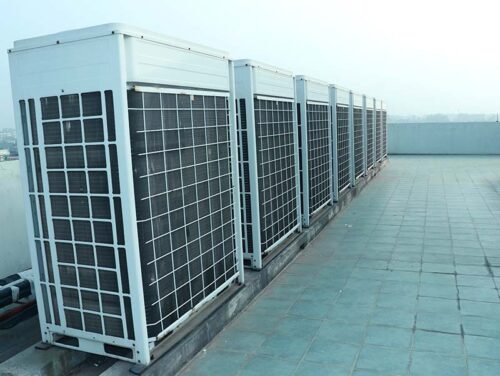For those in the commercial HVAC space, innovation is imperative. For those who operate businesses in NYC, remaining atop of changing HVAC trends is doubly imperative. Variable Refrigerant Flow (VRF) systems are revolutionizing the way we approach heating and cooling in commercial spaces. But what exactly are VRF systems, and why should you, as a commercial building owner or HVAC professional in NYC, consider making the switch?
In this blog post, we’ll discuss the benefits of VRF, explain how they work, and explore key considerations for implementing these advanced HVAC solutions in your commercial buildings.
What Are VRF Systems?

VRF systems are advanced HVAC solutions that provide precise control over heating and cooling in commercial buildings. Unlike traditional HVAC systems that operate on an all-or-nothing principle, VRF can modulate the flow of refrigerant to different zones within a building, allowing for individualized climate control. This system is particularly beneficial for large commercial spaces where different areas may have varying heating and cooling needs.
Efficiency and Energy Savings
One of the most compelling reasons to switch to VRF is its impressive energy efficiency. Traditional HVAC systems often result in energy wastage due to their inability to adjust to varying load requirements. VRF, on the other hand, can dynamically adjust the flow of refrigerant, ensuring that only the necessary amount of energy is used to maintain the desired temperature in each zone — ultimately leading to significant energy savings and lower utility bills.
Additionally, VRF often comes with advanced energy monitoring capabilities. These features allow building owners and facility managers to track energy usage in real-time and identify opportunities for further savings. By reducing energy consumption, VRF not only lowers operating costs but also contributes to a greener, more sustainable environment.
Flexible Installation and Design
VRF systems offer unparalleled flexibility in terms of installation and design. Traditional HVAC systems require extensive ductwork, which can be cumbersome and limit design options. In contrast, VRF uses smaller, more efficient refrigerant lines, which can be easily routed through tight spaces and around architectural obstacles.
This flexibility makes VRF ideal for both new constructions and retrofits. Whether you’re looking to upgrade an existing commercial building or design a new one from scratch, VRF can be tailored to meet your specific needs. The modular nature of these systems also allows for easy expansion, meaning you can add more units as your building’s requirements change over time.
Enhanced Comfort and Control
One of the standout features of VRF is its ability to provide individualized comfort. Traditional HVAC systems often struggle to maintain consistent temperatures across different zones, leading to hot and cold spots. VRF, however, allows for precise control of temperature in each zone, ensuring optimal comfort for occupants.
Building automation systems can easily integrate with VRF technology to provide centralized control and monitoring. This means facility managers can adjust settings remotely, troubleshoot issues, and optimize performance without needing to be on-site. The result is a more comfortable, productive environment for tenants and employees.
Reduced Maintenance Costs
Commercial HVAC systems can be costly to maintain, with regular servicing and potential repairs adding up over time. VRF, however, is designed with reliability and ease of maintenance in mind. Fewer moving parts and advanced diagnostics mean these systems require less frequent maintenance and are less prone to breakdowns.
When maintenance is needed, VRF often allows for easier access to components, reducing the time and labor required for repairs. This translates to lower maintenance costs and less downtime for your building’s HVAC system, ensuring continuous comfort for occupants.
Noise Reduction
In commercial buildings, noise can be a significant concern, particularly in environments where quiet is essential, such as offices, hotels, and healthcare facilities. Traditional HVAC systems can generate considerable noise, disrupting occupants and affecting productivity.
VRF systems operate much more quietly. The outdoor units of VRF are designed to minimize noise, and the indoor units are typically quieter than those of conventional HVAC systems. This makes VRF an excellent choice for maintaining a peaceful and comfortable indoor environment.
Environmental Impact
As evidenced by Local Law 97, the AIM Act, the Green New Deal, and more, sustainability is increasingly a priority for businesses. Luckily VRF systems align with this shift towards greener practices by offering a more environmentally friendly HVAC solution. The advanced energy efficiency of VRF means lower carbon emissions, contributing to a reduced environmental footprint.
In addition, VRF uses refrigerants with lower global warming potential (GWP), further reducing their impact on the environment. By choosing VRF, commercial building owners can demonstrate their commitment to sustainability and appeal to environmentally conscious tenants and clients.
Transitioning to VRF Systems with Donnelly
Switching to VRF offers numerous benefits for commercial building owners and HVAC professionals in NYC. From enhanced energy efficiency and flexible installation to improved comfort and reduced maintenance costs, these advanced HVAC solutions are well worth considering for your next project.
If you’re considering making the switch, look no further than the team at Donnelly Mechanical. For over 30 years, Donnelly has become the leading force in New York City commercial HVAC. From 24/7 emergency services to VRF installation, our trained professionals can help you navigate HVAC problems and provide ongoing support for your building’s HVAC needs.
To learn how Donnelly can do so, please visit our website and contact us today for more.